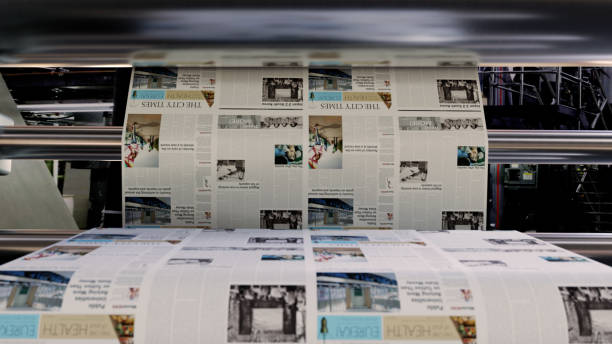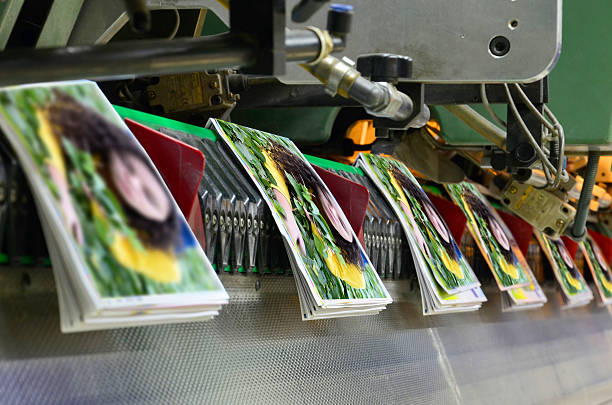
In Australia, the magazine industry is booming, with over 7,400 print magazines available. The “Special Interest” category is seeing the most growth. Despite the digital age, 73% of Aussie adults aged 25 and up still prefer print magazines. In 2023, print magazine sales in Australia saw a 4.1% increase, showing the demand for quality printed content remains strong. Our aim here is to show how to maintai quality without increasing your Magazine Printing Cost.
As a magazine publisher, finding the right printer to keep costs down is essential. With 122 new print magazines launched in 2021, the competition is intense. Keeping a tight budget can be the key to success. From offset printing to digital magazine publishing, the choices are vast but navigating them can be challenging. Our expertise as cheap magazine printing experts can guide you to the perfect printing partner, ensuring your magazine is brought to life without breaking the bank.
The Enduring Allure of Print Magazines
In today’s digital-dominated world, print magazines still hold a special place in the hearts of many in Australia. Despite the rise of online content and e-readers, the unique charm of print magazines stands out. The feel of paper between your fingers and the joy of flipping through glossy pages offer a refreshing break from the digital overload.
The Continued Demand for Printed Magazines
Contrary to predictions, print magazines have seen a resurgence in popularity. People are turning away from digital screens, seeking the sensory pleasure of physical publications. The meticulous attention to detail in print design, from typography to layout, creates a deeper connection with readers. It evokes a sense of nostalgia and engagement.
The Historical Journey of Magazines
- The earliest magazines, like the Erbauliche Monaths-Unterredungen and Le Mercure Galant, began in the 17th century. They catered to the growing interest in intellectual discourse and cultural enrichment.
- In the 18th century, The Tatler and The Spectator emerged, led by figures like Andrew Bradford and Benjamin Franklin. They shaped the magazine journalism landscape.
- The 19th and 20th centuries brought illustrated magazines like the Illustrated London News and the Saturday Evening Post. These magazines captivated readers with their stunning visuals and in-depth reporting.
- Titles like Cosmopolitan and Munsey Magazine further solidified the magazine industry’s influence. They offered a diverse range of content, catering to changing reader preferences.
As the magazine industry evolves in the digital age, the allure of print remains strong. It offers a tactile and immersive reading experience that is deeply valued by audiences in Australia and worldwide.
Navigating Magazine Printing Services

When embarking on a magazine printing project, selecting the right services is paramount. Each choice, from binding styles to paper and ink, affects both cost and quality. Let’s delve into the essential factors for making these decisions. Color magazine printing can significantly enhance the visual impact and quality of your publications.
Binding Styles: Perfect Binding vs. Saddle-Stitching
Choosing the binding style is a critical decision in magazine printing. Perfect binding, or square binding, glues the pages along the spine for a polished look. In contrast, saddle-stitching uses wire staples at the center fold, offering a more budget-friendly yet attractive finish. Additionally, booklet printing provides versatile solutions for various publication needs, ensuring high-quality and customizable options.
Paper and Ink Choices affecting Magazine Printing Cost
The selection of paper and ink greatly influences your magazine’s appearance and cost. Paper weight, finish, and color are key considerations, especially for the interior pages, which can impact the overall quality and cost of the magazine. Thicker paper stocks (80-90 GSM) suggest higher quality, while lighter options are more affordable. The finish, whether matte or glossy, also impacts both look and cost. Using the same paper for both the cover and interior pages can be a cost-effective option.
Ink choice is another critical factor. Full-color printing, or four-color process printing, offers a broad spectrum of colors and high-quality images. Yet, spot color printing, using specific inks, can be more economical for certain designs.
By thoughtfully choosing binding styles and paper and ink, you can create a magazine that’s both professional and budget-friendly. Goliath Print’s experienced team is here to assist, ensuring your magazine printing project is a triumph.
Factors Affecting each Magazine Printing Cost
When it comes to magazine printing, several factors can significantly influence the overall cost. Understanding these elements can help you make informed decisions and optimize your budget effectively.
- Paper Quality and Weight: The type and weight of paper you choose play a crucial role in determining your magazine printing costs. Thicker, high-quality paper stock tends to be more expensive than thinner, lower-quality options. For instance, opting for an 80-90 GSM paper can give your magazine a premium feel but at a higher cost.
- Binding Style: The binding method you select also impacts the cost. Perfect binding, which involves gluing the pages along the spine, generally costs more than saddle stitching, where wire staples are used at the center fold. Each binding style offers different aesthetic and functional benefits, so choose one that aligns with your budget and design goals.
- Page Count: The number of pages in your magazine directly affects the printing cost. More pages mean higher costs, so it’s essential to balance content richness with budget constraints.
- Color Usage: Full-color printing, known as four-color process printing, can significantly increase costs compared to black and white printing. While vibrant, high-quality images enhance the magazine’s appeal, they also add to the expense.
- Quantity: The number of copies you print can influence the cost per unit. Larger print runs often benefit from economies of scale, making them more cost-effective than smaller runs.
- Finishing Options: Additional finishing touches like lamination, spot varnishing, or embossing can enhance the magazine’s look and durability but will add to the overall cost. These options should be considered carefully based on your budget and the desired final product.
By understanding these factors, you can make strategic choices that help manage your magazine printing costs without compromising on quality.
Magazine Printing Options
When it comes to magazine printing, you have several options to choose from, each with its own set of advantages. Here are some of the most common methods:
- Offset Printing: This traditional printing method involves transferring ink onto paper using metal plates. Offset printing is highly cost-effective for large print runs, delivering high-quality results with consistent color and detail. It’s an excellent choice for magazine publishers looking to produce large quantities at a lower cost per unit.
- Digital Printing: Digital printing is a modern technique that prints directly from a digital file. It’s ideal for small to medium-sized print runs, offering fast turnaround times and high-quality images. Digital magazine printing is also more flexible, allowing for quick edits and updates, making it perfect for short-run projects or publications with frequent updates.
- Saddle Stitch Binding: This popular binding method involves stapling folded sheets together along the spine. Saddle stitch binding is cost-effective and works well for magazines with a lower page count. It provides a clean, professional finish without breaking the bank.
- Perfect Binding: Perfect binding, or square binding, involves gluing the pages together along the spine. This method gives your magazine a polished, professional look, making it suitable for higher-end publications. While it is generally more expensive than saddle stitching, it offers a more durable and aesthetically pleasing finish.
By exploring these magazine printing options, you can select the method that best suits your needs and budget, ensuring a high-quality final product.
Digital Magazine Printing
Digital magazine printing has become increasingly popular, especially for small to medium-sized print runs. Here are some of the key benefits:
- Fast Turnaround Times: One of the most significant advantages of digital printing is its speed. It allows for quick setup and fast production, making it ideal for projects with tight deadlines.
- High-Quality Images: Digital printing produces high-quality images with vibrant colours and sharp details. This ensures that your magazine looks professional and visually appealing.
- Cost-Effective: For small to medium-sized print runs, digital printing production is a cost-effective option. It eliminates the need for expensive setup costs associated with traditional printing methods, making it more affordable for smaller quantities.
- Environmentally Friendly: Digital printing is an environmentally friendly option, as it produces minimal waste. It uses less paper and ink, reducing the environmental impact of your magazine printing project.
By opting for digital magazine printing, you can enjoy these benefits while keeping your costs in check and delivering a high-quality publication to your readers.
Design and Artwork Tips

Creating a visually stunning magazine requires careful attention to design and artwork. Here are some essential tips to ensure your magazine is print-ready:
Designing for Print
- Use CMYK Colors: When designing for print, always use CMYK color mode. This ensures that the colors in your design will accurately match the printed output, avoiding any unexpected color shifts.
- Use High-Resolution Images: To ensure your images are clear and vibrant, use high-resolution images (at least 300 DPI). Low-resolution images can appear pixelated and unprofessional when printed.
- Use a Bleed: Incorporate a bleed in your design to ensure that your artwork extends beyond the trim line. This prevents any white edges from appearing on the final printed magazine.
- Use a Safe Zone: Keep important elements like text and logos within the safe zone, away from the edges. This ensures that nothing gets cut off during the trimming process.
- Save as a PDF: Save your final design as a PDF to ensure it is print-ready. PDFs preserve the layout, fonts, and images, ensuring that your design looks exactly as intended when printed.
By following these design and artwork tips, you can ensure that your magazine is printed to the highest quality, meeting your expectations and delighting your readers.
Magazine Printing Cost: Insights from the Experts
Sorcha Hopmans, a veteran from MVP Print, shared her expertise on managing magazine printing costs. With over 22 years in the industry, she highlighted the need to understand the publisher’s business model and schedules. This knowledge can lead to cost-saving suggestions that benefit both the printer and the publisher.
Sorcha noted that magazine printing and binding can be done in 24 hours with same-day printing and next-day shipping. However, for the most cost-effective option, she suggests allowing 6 to 10 business days. For projects with 1500 to 2000 copies, digital press and short-run bindery machines are used for faster turnaround. For larger volumes, offset presses and higher volume bindery machines are employed, leading to slower turnaround but lower costs.
Digital printing suits quantities from one to several thousand, while offset printing is better for large orders. Digital printing allows for quicker editing and printing of images, reducing setup time and speeding up the finishing process. The speed of magazine printing depends on the print company’s systems, processes, and experience with rush projects.
Sorcha pointed out that digital printing is preferred in rush conditions due to its faster setup times and ability to run jobs on multiple printers. This technology offers quicker setup and turnaround for short-run magazine projects. She also mentioned that confirmed orders must be placed by 4 pm AEST every workday, with additional costs for remote or rural locations.
Moreover, Sorcha stressed the importance of lamination and other finishes in maintaining magazine quality and appearance. She noted that lamination can affect printed colors and advised on the use of laminations and finishes to prevent issues like marking and fading. She also provided guidelines for spine dimensions and bleed requirements for Perfect (PUR) and Hardcover items, as well as the limitations of lamination on Uncoated and Recycled Paper stocks.
“Magazine Printing Cost”: Cost-Saving Strategies
In Australia, creators of magazines have various ways to manage their printing costs. Offset printing stands out as a top choice. It delivers high-quality prints at a lower cost, especially for bigger print runs.
Collaborating with printers can lead to cost optimization. This involves looking at paper types, print quantities, and binding styles. For example, choosing less expensive paper or the right binding for the magazine’s size can cut costs.
- Offset printing offers high-quality, cost-effective results for larger print volumes.
- Carefully selecting paper types and weights can help reduce the magazine printing cost.
- Adjusting print quantities to match the target audience can lead to cost-saving strategies and avoid overproduction.
- Exploring binding options like perfect binding or saddle-stitching can help cheap magazine printing without compromising on printing quality.
- Maintaining an open dialogue with the printer can uncover printing budget-friendly solutions tailored to the magazine’s needs.
By adopting these cost-saving strategies, Australian magazine creators can achieve a balance. They can keep costs down while still delivering high-quality, visually appealing publications to their readers.
Conclusion
In the ever-changing world of the Australian magazine industry, print media remains a powerful draw for readers. It offers a real, hands-on experience that digital formats can’t match. Titles like Vogue and GQ continue to attract a large following. Meanwhile, niche magazines are growing fast, showing the ongoing appeal of printed content.
For publishers, understanding magazine printing services and finding ways to save costs is crucial. Working with trusted printers like MVP Print can help manage expenses while maintaining quality. They provide expertise and a variety of binding and paper choices.
As the industry moves forward, magazines that blend compelling content, creative design, and affordable printing will succeed. By valuing the unique strengths of print and listening to their audience, Australian magazine publishers can keep delivering engaging, memorable experiences. This will ensure readers stay loyal, returning year after year.








